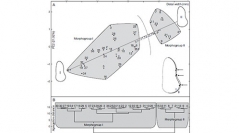

 Geodiversitas
34 (4) - Pages 961-975
Geodiversitas
34 (4) - Pages 961-975The first lower molars of the cave bear Ursus spelaeus Rosenmüller, 1794 exhibit a high variability in size and shape. An outline analysis via the elliptic Fourier transform has been performed on a population from the oldest archaeological deposit (Level 4, Upper Pleistocene) of the Trou du Sureau (Montaigle caves, Belgium) in order to quantify the intra-specific morphological plasticity. The size and shape descriptors were extracted and results were compared to traditional measurements of length, mesial width, distal width and height. We determinated a few individual parameters, such as the individual age, the laterality and a few Rabeder’s morphotypes and we tested their effect on the morphological variability. Results indicate no significant relationship between the shape variability and the individual parameters, except for the metastylid conformation and the laterality. The metastylid would induce a decoupling in the evolution of the size and the shape, maybe related to differences in the evolutionary patterns. The effect of the laterality could not be clearly established because it seems closely linked to the distribution of the metastylids in our sample. A marked polymorphism could be interpreted as a sexual dimorphism or could more probably correspond to two distinct cave bear sub-populations. Finally, our analysis demonstrates the feasibility of the outline analysis on ursid dental elements and provides a preliminary step before applying this method at an inter-specific level.
Cave bear, first lower molar, occlusal surface, intra-specific variability, outline analysis, geometric morphometrics